 A couple of weeks ago Anne Hill, host of Dream Talk Radio, invited me to talk about the book I recently co-authored with my mother, Children’s Dreams: Understanding the Most Memorable Dreams and Nightmares of Childhood (Rowman & Littlefield, 2012). Here’s a Youtube link to our discussion, which I thought was really fun. Below I’ve posted some additional review and endorsement comments about the book. I’m curious to hear from anyone else who gets a chance to read it! Continue reading “Children’s Dreams Interview with Anne Hill”
A couple of weeks ago Anne Hill, host of Dream Talk Radio, invited me to talk about the book I recently co-authored with my mother, Children’s Dreams: Understanding the Most Memorable Dreams and Nightmares of Childhood (Rowman & Littlefield, 2012). Here’s a Youtube link to our discussion, which I thought was really fun. Below I’ve posted some additional review and endorsement comments about the book. I’m curious to hear from anyone else who gets a chance to read it! Continue reading “Children’s Dreams Interview with Anne Hill”
Dreaming in the World’s Religions: A Comparative History (2008)
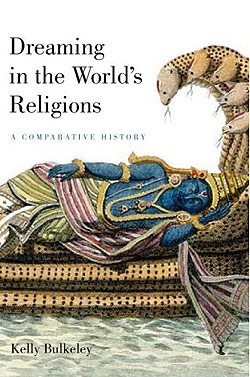 New York University Press
New York University Press
July 2008
From Biblical stories of Joseph interpreting Pharaoh’s dreams in Egypt to prayers against bad dreams in the Hindu Rg Veda, cultures all over the world have seen their dreams first and foremost as religiously meaningful experiences. Dreaming in the World’s Religions provides an authoritative and engaging one-volume resource for the study of dreaming and religion. It tells the story of how dreaming has shaped the religious history of humankind, from the conception dream of Buddha’s mother to the sexually tempting nightmares of St. Augustine, and from the Ojibwa vision quest to Australian Aboriginal journeys in the Dreamtime. Dreaming in the World’s Religions offers a carefully researched, accessibly written portrait of dreaming as a powerful, unpredictable, often iconoclastic force in human religious life.
“A pleasure to read, well written and full of fascinating examples. It combines a sensitive and sympathetic understanding of the religious meanings of dreams with a state-of-the-art treatment of the insights that cognitive neuroscience and evolutionary psychology bring to our understanding of them.” –Wendy Doniger, Mircea Eliade Professor of the History of Religions, University of Chicago, and author of Dreams, Illusion, and Other Realities
“Offers a sophisticated, yet easily accessible and engaging discussion of how and in what way dreams and a broad range of the world’s religions have enjoyed mutual influence throughout history. . . . This book is unique in that is provides a valuable resource for the serious scholar of religion, yet has equal potential for non-specialists interested in exploring how their own dreams may find relevance for their own lives, religious or otherwise.” –Nina P. Azari, Editor-in-Chief of the Encyclopaedia of Sciences and Religions
Main findings:
1. Dreams have strongly influenced the beliefs and practices of religious traditions all over the world, throughout history.
Each of the ten chapters of the book is devoted to a different religious tradition (or family of traditions) and its historical teachings about dreams, including Hinduism, Chinese religions, Buddhism, religions of the Fertile Crescent, Greek and Roman religions, Christianity, Islam, and the indigenous cultures of Africa, Oceania, and the Americas. In every case, dreams appear as a powerful medium of transpersonal guidance offering the opportunity to communicate with divine beings, gain wisdom and power, heal suffering, and explore new realms of existence.
2. Dreams and reason are not mutually antagonistic.
Voices of critical questioning and naturalistic analysis have risen up wherever and whenever humans have explored their dreams. It might be a surprise to those who assume that modern scientists were the first to explain dreaming as the mental by-products of sleep, but many ancient traditions recognized exactly the same psychophysiological dynamics at work in people’s dreams. The skeptical perspective did not come after religious perspective, nor even before it. Historically speaking, the two approaches are not mutually exclusive. They have coexisted from the start. The prototypical experiences of dreaming have provoked not only religious and spiritual experience but also a deeply human capacity for rational thought and critical reflection. Dreams have stimulated the power of reason to become increasingly aware of deceptive appearances, hidden connections, subtle perceptions, and cognitively impactful emotions.
3. Dreaming is a primal wellspring of religious experience.
This means that dreams, by virtue of their natural emergence out of the immensely complex, internally-generated activities of the mammalian brain during sleep, offer all human beings a potential source of visionary insight, creative inspiration, and expanded self-awareness. The abundant evidence of cross-cultural history proves that we are indeed a dreaming species. Through dreams humans have discovered the deepest realms of their psyches and grown in awareness of the powerful relational bonds that connect them to their families, communities, natural environments, religious traditions, and ultimately the cosmos itself. Whether dreaming came before religion or religion came before dreaming is an impossible question to answer. But we now have evidence strongly suggesting that the natural rootedness of dreaming in the human brain-mind system makes it a universally available source of experiential awareness of precisely those powers that people have historically associated with religion. To accept that evidence does not mean abandoning science or pledging faith to some religious creed or dogma. Rather, it means acknowledging the reality of an autonomous visionary capacity within the human brain-mind system, a capacity driven by an unconscious intelligence deeply rooted in our biological nature yet continuously striving for transcendent understanding and insight.
4. The pan-human prototypes of dreaming are rooted in the brain, the body, and the evolutionary history of our species.
In almost every known cultural tradition, people have described certain types of intensified, highly memorable dreams (e.g., flying, falling, being chased or attacked, meeting a dead relative, having sex), and I refer to them collectively as prototypical dreams Prototypical dreams are not universal in the sense that every single person experiences all of them. Rather, they are latent forms of dreaming potential. They reflect innate predispositions to dream in certain ways that, when actualized, make unusually strong impressions on waking awareness. In contrast to the vast majority of sleep experiences that fade into oblivion, prototypical dreams are actually quite easy to remember. Some of them are literally impossible to forget, remaining a vivid presence in people’s memories for the rest of their lives.
My basic argument in the book is that highly memorable prototypical dreams have played a powerfully creative role in virtually all the world’s religious and spiritual traditions. The consciousness-provoking impact of dreaming has not been sufficiently recognized by scientists or religious studies scholars, and my hope is to present a compelling case for taking dream experiences more fully into account in the comparative study of religion.
Each of the four prototypes I discuss is clearly associated with a distinct kind of carry-over effect of dreaming experience into the waking state. With sexual dreams the carry-over is a physical orgasm, of both the male and female varieties. With aggressive dreams it’s the hyper-activation of the fight/flight response—extreme fear, racing heart, rapid breathing, and full-body sweat. With gravitational dreams it’s the horribly realistic sensation of falling and waking up with a sudden gasping start. With mystical dreams it’s the blissful, ultra-realistic sensation of flying or the profound joy of being reunited with a deceased loved one. These kinds of direct emotional and bodily continuations of the dreaming experience into the person’s waking life are perhaps the strongest and most easily observed instances of the deeply rooted interplay of dreaming and waking consciousness. The palpable carry-over effects associated with prototypical dreams are clues to the specific processes by which dreaming contributes to healthy brain-mind functioning. Aggressive dreams reflect an adaptive concern with identifying and responding to threats in the waking world. Although emotionally disturbing, such nightmares have the beneficial effect (in survival terms) of stimulating greater waking-world vigilance toward similar threats. The evolutionary logic is simple: the more often and more intensely you dream of various kinds of threatening situations, the better prepared you’ll be to react effectively to those situations if and when they occur in waking life. Likewise with gravitational dreams, which accurately reflect and simulate the existential dangers of entropic destruction. The intense fear and horror generated by these dreams activates the fundamental instincts of self-preservation that must always be ready to respond immediately should a comparable danger arise in the waking world, whether it be falling off something high, getting in a car crash, or losing physical mobility. Sexual dreams prompt the reproductive system and envision a variety of possible ways of satisfying its desires. Their stimulating and taboo-defying effect on the erotic imagination is, I suspect, self-evident to most readers. The impact of mystical dreams is less directly tied to evolutionary biology, and more to the emerging spirit of human creativity. Dreams of the mystical prototype have the effect of enlarging people’s sense of life’s possibilities, expanding their awareness from a narrow fixation on what is to a broader consideration of what might be. Such dreams stretch the mind by pushing it to become more conscious of its own powers and the realities that extend beyond what is immediately present in normal perceptions of the waking world.
Dreaming Beyond Death: A Guide to Pre-Death Dreams and Visions (2005)
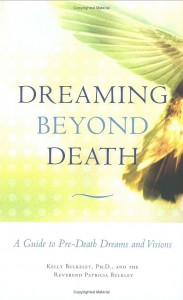 Dreaming Beyond Death: A Guide to Pre-Death Dreams and Visions (2005)
Dreaming Beyond Death: A Guide to Pre-Death Dreams and Visions (2005)
By Kelly Bulkeley and the Rev. Patricia Bulkley
(Beacon Press, 2005)
Purchase this Book – Cloth
Purchase this Book – Paperback
Pre-death dreams and visions have been reported throughout history by people in cultures all over the world. The same is true today, when terminally ill people experience strange dreams in the final days of their lives. These dreams often have a remarkable impact on the dying person: as a direct result of the dream or vision, the person’s fear of death diminishes, replaced by a new understanding of living, dying, and that which lies beyond death. Dreaming Beyond Death combines fascinating stories of contemporary dreamers, the latest scientific research on dreams, and the insights of the world’s religious traditions to provide a simple, spiritually-sensitive approach to understanding these remarkable end-of-life experiences. Written for those who are dying and their caregivers (family, friends, clergy, medical staff), this book is an invitation to discover the surprising potential for personal change and religious transformation that opens up as mortal life draws to a close.
Newsweek Article…
Blurbs and Reviews
“This highly readable volume is a treasure trove of compelling, original insights to excite the mind and the spirit through the journey of dying, healing, and hope. I cannot recommend it highly enough.”
–Rabbi Earl Grollman, author of Caring and Coping When Your Loved One is Severely Ill
“By investigating the metaphor-making power of dreams, this profound book not only bridges life and death, emotion and reason, science and the care of the dying, but the generational difference between this wonderful mother-son team of authors. Dreaming Beyond Death is a great contribution to both science and the challenge of facing death.”
— Don Browning, Professor of Religious Ethics and the Social Sciences and author of Religious Thought and the Modern Psychologies
“In earlier days in Western culture, there existed an Art of Dying. It got lost. Dr. Kelly Bulkeley and Rev. Patricia Bulkley help us recover it. They show how dreams can move us beyond thresholds, carrying us like vehicles into the unknown. Dreams cloak us in almost-understanding and in mystery. They speak to the heart, and whisper us along the implacable path. At a moment when guidance is of the utmost importance, dreams speak. This book makes them accessible. I took up this text just to skim through it and became utterly engrossed, reading every word in one sitting.”
— Robert Bosnak, author of A Little Course in Dreams, Dreaming with an AIDS Patient, and Tracks in the Wilderness of Dreaming
Table of Contents
Introduction
1. Dreams of Mortality
2. The Nature and Meaning of Dreams
3. Journeys
4. Guides
5. Obstacles
6. Care For the Dying
Conclusion
Appendix: Resources for Caregiving for the Terminally Ill
American Dreamers: What Dreams Tell Us about the Political Psychology of Conservatives, Liberals, and Everyone Else
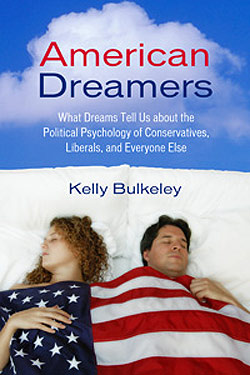 When politicians and pundits refer to the American Dream, they are evoking images of national unity, identity, and a better future. But in what ways does this metaphor manifest in the literal dreams of sleeping Americans? In American Dreamers, dream researcher Kelly Bulkeley takes the ideology of the American Dream one step further—into the study of actual dreams—to explore how the nocturnal side of human existence offers a key to the psychological origins of people’s waking beliefs and political passions.
When politicians and pundits refer to the American Dream, they are evoking images of national unity, identity, and a better future. But in what ways does this metaphor manifest in the literal dreams of sleeping Americans? In American Dreamers, dream researcher Kelly Bulkeley takes the ideology of the American Dream one step further—into the study of actual dreams—to explore how the nocturnal side of human existence offers a key to the psychological origins of people’s waking beliefs and political passions.
Building on sixteen years of scientific research involving thousands of dream reports, Bulkeley shows how the playful fancies of people’s dreaming imaginations can be interpreted as insightful expressions of their hopes and fears about issues as varied as the environment, religion, family values, and the Iraq war. Examining in particular detail the dreaming tendencies of conservatives and liberals, the book centers on ten people of different political perspectives—a dreamers’ focus group—who kept yearlong sleep and dream journals. The dreaming and waking stories of these “ordinary” Americans (among them a cancer survivor, a lesbian horse rancher, a former Catholic priest, a young waitress engaged to be married, and a soldier preparing for his third tour to Iraq) provide raw psychological material and a window into their deepest beliefs, darkest fears, and most inspiring ideals.
Hyper-ventilating political pundits have described in lurid detail what conservatives and liberals disagree about but rarely do they try to explain why they disagree—and that’s the real question. At a time of bitter partisan conflict and governmental paralysis, American Dreamers calls the country back to its visionary origins, arguing that dreams can serve as a royal road to the creation of new political solutions that integrate the best of conservative and liberal ideals. If we truly want to learn something new about the American Dream in people’s lives today, Bulkeley proposes we take a good, close look at how well American people are sleeping and dreaming at night.
Main findings:
1. Conservatives are more likely to sleep well and report fewer dreams, and liberals are more likely to sleep worse and report more dreams.
This is the overall conclusion of the sleep and dreams poll (sleep and dream poll results: political ideology), and it’s consistent with the same finding in my earlier studies (KB articles 2002 and 2006). It must be said, however, that some conservatives report many dreams, and some liberals report none; the distinctions are not absolute. In fact, the book’s analysis of more than 1500 dreams recorded in home journals by a group people with mixed political views (The 10 members of the “dreamers focus group”) reveals a much more complex psychological process at work, with conservative and liberal tendencies interacting in each person’s dreams in unexpected ways. Still, taking all the evidence as a whole, it seems fair to propose the working hypothesis that conservatives tend to be good sleepers and minimal dreamers, while liberals tend to be troubled sleepers and expansive dreamers.
2. The most religiously observant Americans (attend a worship service more than once a week) report better sleep and fewer dreams than the least religious Americans (never attend a worship service).
This was a surprising finding (sleep and dream poll results: religion), insofar as other research has indicated a close relationship between dreaming and religion (Dreaming in the World’s Religions: A Comparative History). These results may be due to a) the connection between religion and conservative politics in America, and/or b) the connection between American liberalism and a “spiritual but not religious” perspective. Chapter 3 looks at the religious and spiritual beliefs of the ten journal-keepers, who range across the spectrum from conservative Christian to liberal atheist.
3. A surprisingly frequent type of dream among both conservatives and liberals is a nightmare about work.
This is the most unexpected finding, because it reveals the impact of economic pressures on sleeping and dreaming in ways that no previous research has shown (sleep and dream poll results: economic status). Chapter 5 of the book discusses the economic circumstances of the focus group members, most of whom struggled financially during the journal-keeping year. Their job-related dreams reveal a profound populist frustration with the economic status quo.
4. The continuity of waking and dreaming extends to political ideals, beliefs, and attitudes.
Analysis of the dreams of the ten journal-keepers adds further evidence to the continuity hypothesis (www.dreamresearch.net), which says that dream content accurately reflects the most important concerns of the individual’s waking life. The findings in this book show that basic, easily identified patterns in dream content are continuous with a person’s most meaningful and emotionally intense relationships, activities, and beliefs. Those beliefs include a person’s attitudes toward politics. Perhaps one day we’ll be able to predict people’s political views with no information other than the patterns of their dreams.
Blurbs
“A beautifully written reminder of the depth of differences, and a dream of how difference might be understood. Bulkeley understands something profound about us; we would benefit enormously if we could even just glimpse that understanding.”—Lawrence Lessig, author of The Future of Ideas and Free Culture and Professor of Law, Stanford Law School
“No book about dreams could be more timely or more important than Kelly Bulkeley’s American Dreamers. Whatever is important in people’s waking lives is reflected in their dreams–politics included. American conservatives report different dreams than American liberals. American Democrats report different dreams than American Republicans. Dr. Bulkeley paints his portraits of American dreamers with a palette that reflects his scholarship in both religious studies and dream science; the results are filled with insights that will delight, amuse, and infuriate his readers. American Dreamers provides its readers with insight into the country’s future, insight that is available from no other (or better) source.”—Stanley Krippner, Ph.D., Co-author, Haunted by Combat: Understanding PTSD in War Veterans
“This story we tell ourselves in our dreams passes the impurities of our waking life through an ethical filter and exposes truths we have not yet acknowledged. American Dreamers is a comprehensive and very readable account of our unconscious adaptation of what is still a hazardous and imperfect waking domain. Bulkeley’s professional life has revolved around dreams and what we can learn from them. This book is true to its title. He has opened the door to the sociology of dreams.”—Montague Ullman, M.D., author of Appreciating Dreams: A Group Approach and Clinical Professor of Psychiatry Emeritus, Yeshiva University
“In this ground-breaking and timely work, Kelly Bulkeley uses the psychological analysis of dreams to plumb the depths of political, religious, and cultural realities. With an exemplary grasp of dream science built upon thousands of dream accounts, Bulkeley presents a multifaceted and nuanced portrait of the ways our deeply seated ideas, values, virtues, and fears become apparent within our dreams. American Dreamers challenges us to develop a greater understanding of and respect for all people across the political spectrum.”—Bonnie J. Miller-McLemore, author of In the Midst of Chaos and Let the Children Come
“Any political pundit who wants to speak with intelligence and genuine insight about the psychological motivations of American voters across the political spectrum would be well advised to read Kelly Bulkeley’s American Dreamers. Kelly Bulkeley is arguably the most rigorously empirical and psychologically subtle contemporary interpreter of the phenomenon of human dreaming. Over twenty-five years of writing and research is deployed in this urgently relevant, non-partisan, and broadly sympathetic analysis of the underlying psychological and spiritual concerns that unconsciously organize the political views of ordinary Americans today.”—John McDargh, author of Psychoanalytic Object Relations Theory and the Study of Religion and Associate Professor of the Psychology of Religion, Boston College
Dreaming in the Classroom: Practices, Methods, and Resources in Dream Education
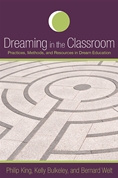 Phil King, Bernard Welt and I have written the newly released DREAMING IN THE CLASSROOM: PRACTICES, METHODS, AND RESOURCES IN DREAM EDUCATION, from the State University of New York Press. It has been a long time coming, and we are grateful to all the teachers we interviewed in the course of our research.
Phil King, Bernard Welt and I have written the newly released DREAMING IN THE CLASSROOM: PRACTICES, METHODS, AND RESOURCES IN DREAM EDUCATION, from the State University of New York Press. It has been a long time coming, and we are grateful to all the teachers we interviewed in the course of our research.
The back-cover endorsement comes from Ernest Hartmann, psychiatrist from Tufts University Medical School, who says, “This book will be extremely useful to educators at all levels. It can be considered the King James Bible of the field of dream education.”
The cover of the book is a photo taken by Justin Knight of the walking labyrinth in the back courtyard of Harvard Divinity School in Cambridge, Massachusetts. The creation of this labyrinth was inspired by a dream experienced by Laura Lamp, an administrator at HDS.
The first two chapters lay out the basic issues and principles that come into play any time a teacher brings the subject of dreams into the classroom. We especially emphasize dreaming as a resource in writing and composition classes, connecting dream experience with the development of fundamental academic skills.
Then come chapters on teaching dreams in specific disciplines at the college and graduate level: psychology, anthropology, philosophy and religious studies, general humanities, film studies, and psychotherapy and counseling. After that is a chapter on dream education in community/alternative settings, and a chapter on dream education with younger students in primary and secondary schools. We finish with reflections on “the future of dream education.”
It felt good last week to give a copy of the book to my youngest son’s 4th grade teacher, Jeff Grether at Windrush School, whose dream-and-writing assignment is mentioned on p. 182.
Now that I’ve got my own copy in hand, I feel the most valuable part of the book comes in the appendices, which offer an amazing variety of resources for teachers and aspiring teachers:
A. A Dreams Reading List
B. Course Syllabi
C. Establishing and Organizing Community Dream Groups
D. Outline for Short Presentations on Dream
E. Using the Dreambank
F. Preserving Narrative Meanings in Dream Content Analysis
G. Interdisciplinary Dream Course Template
H. Proposing a Course on Dreaming
I. Assessment of Educational Effectiveness in Dream Studies
J. Why I Teach Dreams in Freshman Composition (by Barbara Bishop)
Dreaming in Christianity and Islam
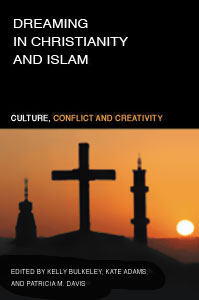 At a time when Christianity and Islam appear to be mortal enemies locked in an increasingly bloody “clash of civilizations,” new insights are needed to promote better mutual understanding of the two traditions’ shared values. Dreaming in Christianity and Islam: Culture, Conflict, and Creativity (edited by Kelly Bulkeley, Kate Adams, and Patricia M. Davis (Rutgers University Press, 2009) provides exactly that. This new book is a collection of articles by international scholars who illuminate the influential role of dreaming in both Christianity and Islam, from the very origins of those traditions up to the present-day practices of contemporary believers.
At a time when Christianity and Islam appear to be mortal enemies locked in an increasingly bloody “clash of civilizations,” new insights are needed to promote better mutual understanding of the two traditions’ shared values. Dreaming in Christianity and Islam: Culture, Conflict, and Creativity (edited by Kelly Bulkeley, Kate Adams, and Patricia M. Davis (Rutgers University Press, 2009) provides exactly that. This new book is a collection of articles by international scholars who illuminate the influential role of dreaming in both Christianity and Islam, from the very origins of those traditions up to the present-day practices of contemporary believers.
Dreams have been a powerful source of revelation, guidance, and healing for generations of Christians and Muslims. Dreams have also been an accurate gauge of the most challenging conflicts facing each tradition. Dreaming in Christianity and Islam is the first book to tell the story of dreaming in these two major world religions, documenting the wide-ranging impact of dreams on their sacred texts, mystical experiences, therapeutic practices, and doctrinal controversies.
The book presents a wealth of evidence to advance a simple but, in the contemporary historical moment, radical argument: Christians and Muslims share a common psychospiritual grounding in the dreaming imagination. While careful, sustained attention will be given to the significant differences between the two traditions, the overall emphasis of the book is on the shared religious, psychological, and social qualities of their dream experiences.
Throughout their respective histories Christians and Muslims have turned to dreams for creative responses to their most urgent crises and concerns. In this book the contributors apply that same imaginative resource to the current conflict between the two traditions, seeking in the depths of dreaming new creative responses to the global crisis of religious misunderstanding and fearful hostility. Included in the book are chapters on dreams in the Bible and Qur’an; on the early history of Christian and Muslim beliefs about dreaming; on religious practices of dream interpretation; on the dreams of children, women, college students, and prison inmates; and on the use of dreams in healing, caregiving, and creative adaptation to waking problems.
